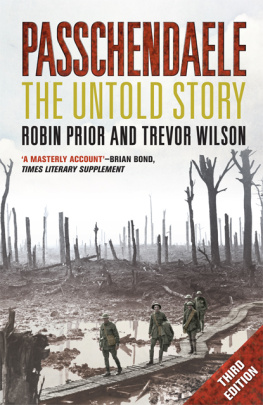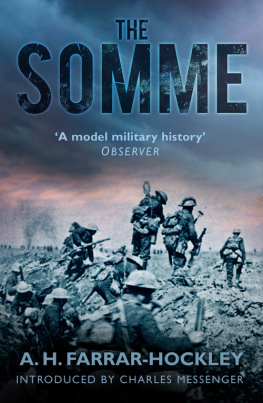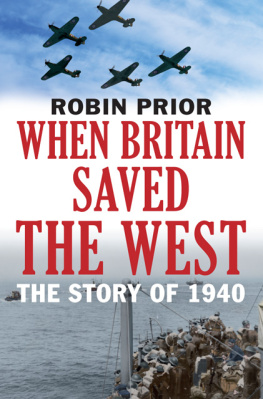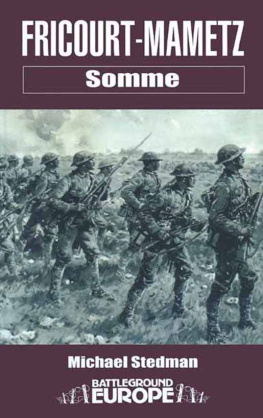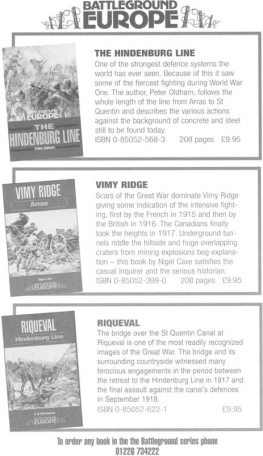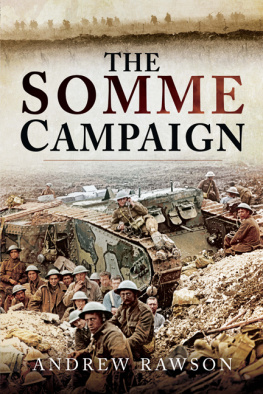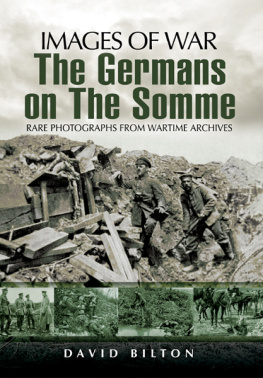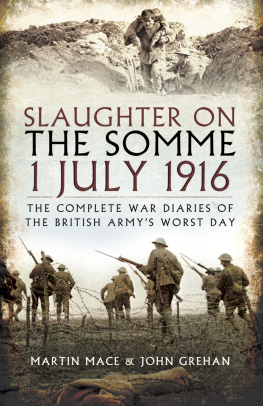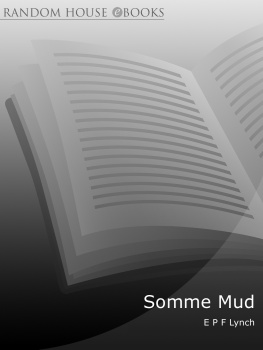Prior Robin - The Somme
Here you can read online Prior Robin - The Somme full text of the book (entire story) in english for free. Download pdf and epub, get meaning, cover and reviews about this ebook. year: 2008;2017, publisher: Yale University Press, genre: History. Description of the work, (preface) as well as reviews are available. Best literature library LitArk.com created for fans of good reading and offers a wide selection of genres:
Romance novel
Science fiction
Adventure
Detective
Science
History
Home and family
Prose
Art
Politics
Computer
Non-fiction
Religion
Business
Children
Humor
Choose a favorite category and find really read worthwhile books. Enjoy immersion in the world of imagination, feel the emotions of the characters or learn something new for yourself, make an fascinating discovery.

- Book:The Somme
- Author:
- Publisher:Yale University Press
- Genre:
- Year:2008;2017
- Rating:3 / 5
- Favourites:Add to favourites
- Your mark:
- 60
- 1
- 2
- 3
- 4
- 5
The Somme: summary, description and annotation
We offer to read an annotation, description, summary or preface (depends on what the author of the book "The Somme" wrote himself). If you haven't found the necessary information about the book — write in the comments, we will try to find it.
The Somme — read online for free the complete book (whole text) full work
Below is the text of the book, divided by pages. System saving the place of the last page read, allows you to conveniently read the book "The Somme" online for free, without having to search again every time where you left off. Put a bookmark, and you can go to the page where you finished reading at any time.
Font size:
Interval:
Bookmark:


For Heather and Jane
And in memory of John Grigg
Scholar and Friend
Copyright 2005 by Robin Prior and Trevor Wilson
First printed in paperback 2006
All rights reserved. This book may not be reproduced in whole or in part, in any form (beyond that copying permitted by Sections 107 and 108 of the U.S. Copyright Law and except by reviewers for the public press) without written permission from the publishers.
For information about this and other Yale University Press publications, please contact:
U.S. Office:
Europe Office:
Set in Minion by Northern Phototypesetting Co. Ltd, Bolton
Printed in Great Britain by St Edmundsbury Press Ltd, Bury St Edmunds
Library of Congress Cataloging-in-Publication Data
Prior, Robin.
The Somme/Robin Prior and Trevor Wilson.
p. cm.
Includes bibliographical references and index.
ISBN 0300106947 (cl.: alk. paper)
1. Somme, 1st Battle of the, France, 1916. I. Wilson, Trevor, 1928 II. Title.
D545.S7P75 2004
940.4'272dc22
2004028497
A catalogue record for this book is available from the British Library.
10 9 8 7 6 5 4 3 2 1
Contents
Maps
Acknowledgements
The authors wish to acknowledge the many people and institutions that have helped them in the research and production of this book about the British experience at the Somme.
Firstly, they wish to thank their colleagues at their respective university departments whose encouragement has been much appreciated. In his School Robin Prior wishes to mention in particular the help he received from Elizabeth Greenhalgh and for the many discussions with her on the First World War. He also wishes to thank Bernadette McDermott, Deborah Furphy, Elsa Selleck, Julie McMahon, Shirley Ramsay, Marilyn Anderson-Smith and Lyn Weaver for helping in various ways, not least in preparing a readable manuscript no mean feat given his handwriting.
To Robert King, the former Rector of UNSW@ADFA, Robin Prior owes special thanks. It is a rare university administrator who still thinks that the Head of a School should have the right to undertake scholarly research.
The authors wish to thank the following research institutions for granting access to material in their archives. In London: the Public Record Office (now sadly renamed the National Archives), the efficiency of which is a marvel; the Liddell Hart Centre at King's College; the Royal Artillery Institution in Woolwich; and the Imperial War Museum, where Rod Sudderby and his expert staff make research work a pleasure. Robin Prior wishes especially to thank Rod for drawing the Horne Papers to his attention. In Canberra: the Australian War Memorial.
Robin Prior expresses his gratitude to the Institute for Advanced Studies at the Australian National University for offering congenial facilities and company for a semester in 1997. He would also like to thank Professor Joanna Bourke of Birkbeck College, London; Professor Carl Bridge at the Menzies Centre in London; and Professor John Moses at the University of New England for opportunities to test chapters of this book on expert audiences.
Both authors wish to thank Keith Mitchell for preparing the maps from their often incomprehensible drafts.
The authors would like to thank their publisher, Robert Baldock, and his expert team at Yale University Press, London. Robert is a publisher par excellence and a great friend. It is also a pleasure to deal with people of the professionalism of Candida Brazil and Ewan Thompson. Their efforts have improved the text and saved us from many errors and grotesqueries (a word they would not approve) of style.
Robin Prior owes an even greater debt to his wife than usual. She not only read the entire manuscript several times and made many improvements, she also assisted in a considerable way with the research. About 600 British battalions fought on the Somme and without Heather's help many of their war diaries would have remained uncopied and unseen and this book would have been the poorer. Robin would also like to thank his daughter, Megan, for help in compiling the index.
1 The Context
I
There is a widely held view about the initiation and prosecution of the Battle of the Somme. It is that the Somme campaign was the brainchild of the British and French military commands alone. That is, the political leaders of Britain (like those of France) played no effective part in this decision-making. Such a proceeding was at odds with British constitutional tradition, whereby high military strategy remained the province of the civilian heads of government.
A large generalisation follows from this. It is that what was true of the Somme battle in 1916 was true of the First World War as a whole. The British military command, who are deemed men of desperately limited strategic horizons and a fixed unwillingness to learn, did the deciding all the way through. Invariably, they opted to strike where the enemy was strongest and best prepared, which meant the Western Front. As a consequence, civilian leaders blessed with more imagination, and dismayed by heavy casualties, went unregarded. The results for the devoted rank and file of the British army were tragic: vast casualties sustained for derisory gains.
The civilian leaders of the nation, according to this scenario, were overall possessed of larger vision and greater strategic insight. They recognised the folly of hammering away on the stalemated Western Front, and perceived hopeful ways of proceeding elsewhere. But ultimately they proved incapable of imposing their views. The contrast with the Second World War is taken to be marked. In that struggle the political rulers of Britain exercised their rightful dominion over the making of strategy, and thereby avoided the terrible bloodbaths of 191418.
II
In this version, the Somme campaign stemmed from a conference held at French military headquarters in Chantilly early in December 1915. It was summoned by the French commander-in-chief, Marshal Joseph Joffre, and attended by representatives of the other Allied armies: British, Russian, and Italian. The principal British figures were Sir John French, commander of the British Expeditionary Force on the Western Front, and Sir Archibald Murray, Chief of the Imperial General Staff.
The decisions taken at Chantilly were as follows.
First, it was agreed that large offensive actions by the four Allies would be undertaken in 1916, and would be launched as near simultaneously as possible. Thereby Germany would be assailed on every front at the same time, and so be prevented from deploying its forces first against one adversary and then against another.
Second, it was decided that Allied endeavours in areas away from the major fronts would either be abandoned altogether, as in the case of Gallipoli, or reduced to a minimum, as with Mesopotamia and Salonika. The British representatives even argued for the total abandonment of the Salonika operation, given that the initial object of sending an Anglo-French expedition there (the rescue of Serbia) had conspicuously failed. The decision however at French insistence was for quiescence rather than complete evacuation.
The third decision, and that most germane to this study, concerned the objectives of the Allies' near-simultaneous offensives. The Italians would resume their Isonzo offensive northwards into the territory of Austria-Hungary. The Russians, who had spent most of 1915 being forced into retreat by better equipped and led German forces, would launch a great effort on their more northerly front against the German army, with a lesser holding action in the south against the Austro-Hungarians. The British and French armies would act side by side in a great endeavour on the Western Front, with the French providing the major component but with the British offering a much larger participation than hitherto. Its location would be Picardy, on either side of the River Somme.
Next pageFont size:
Interval:
Bookmark:
Similar books «The Somme»
Look at similar books to The Somme. We have selected literature similar in name and meaning in the hope of providing readers with more options to find new, interesting, not yet read works.
Discussion, reviews of the book The Somme and just readers' own opinions. Leave your comments, write what you think about the work, its meaning or the main characters. Specify what exactly you liked and what you didn't like, and why you think so.

